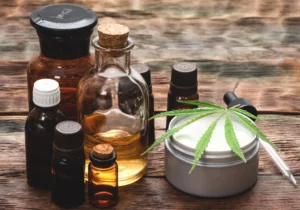The opioid epidemic has reached epic proportions—in 2016 it decreased overall life expectancy in the United States for the second year in a row. As doctors and patients seek alternatives to pain management, one plant comes up time and time again: marijuana.
According to various surveys and studies conducted across the country, cannabis may be our best hope for combating the opioid crisis. Marijuana’s pain-fighting properties can help people reduce or even stop their opioid consumption altogether.
FOLLOW US ON FACEBOOK & INSTAGRAM
Understanding Opioid Tolerance, Dependence & Addiction
Opioids are a class of compounds that work on the body’s opioid receptors to produce sedative, pain-relieving effects. Our bodies make opioids like endorphins, but they also come in the form of legal prescription medications like oxycodone, hydrocodone, codeine, morphine and fentanyl—and in illegal forms like heroin.
Opioids relieve pain by attaching to receptors on your brain cells. This initiates a process that rewards you with feelings of pleasure—ones you’d feel when engaging in basic, necessary life functions like eating and having sex. When opioids activate these reward processes—especially when you’re not in pain, they tend to encourage repeated use simply because they make you feel good.
Repeated exposure to opioids alters your brain chemistry to the point where the brain functions normally when these narcotics are present, and abnormally when they aren’t. Once this happens, tolerance and dependence can occur. Tolerance requires the user to take more and more of a drug to get the desired effect. Dependence occurs when your body needs the drug to prevent withdrawal symptoms such as muscle pains, sweating and tremors.
RELATED: THE RISE OF OPIOIDS—AND CANNABIS’S ROLE IN THEIR DOWNFALL
Continued use of opioids due to tolerance or dependence can change brain function to the point where the user becomes addicted to the drug. Addiction is characterized first and foremost by cravings. These cravings lead the user to exhibit symptoms of addiction, which include: inability to control drug use and compulsive drug use—both of which can cause harm to the user and others. It’s important to note that there are many factors, such as environment and genetic makeup, that contribute to addiction.
Opioid dependency and addiction are considered chronic medical disorders and both long- and short-term treatments are available. Long-term approaches attempt to reverse the abnormal brain functions that drive cravings and compulsions, whereas short-term therapies are aimed at detoxification and relief of withdrawal symptoms.
Both long- and short-term treatments can also include other approaches such as behavioral therapy. However, none of these approaches are effective at relieving long-term chronic pain, which is one of the reasons people are initially prescribed these addictive substances.
Opioid Abuse: The Numbers
According to the American Society of Addiction Medicine, drug overdose is the leading cause of accidental death in the U.S., and opioid addiction is driving this epidemic: Of the 54,404 overdose deaths in 2015, 20,101 of those deaths were related to prescription pain relievers and 12,990 were related to heroin.
From 1999–2008, overdose deaths, sales and enrollment into substance abuse disorder treatment—all related to prescription pain relievers—increased in parallel with each other. The overdose death rate quadrupled from 1999–2008; sales of prescription pain relievers from 1999–2010 also quadrupled; and admission in substance abuse disorder treatment programs increased six-fold from 1999–2009.
Women and those with pre-existing mental health problems are more likely to abuse opioids. According to a 2013 CDC report, women are more likely to have chronic pain and be prescribed prescription painkillers than men are. They’re also more likely to be given higher doses and stay on prescription medications for longer.
Deaths from prescription painkillers have risen more sharply among women than they have in men: Since 1999, women have seen a 400% increase in mortality compared to a 256% increase in men.
According to a 2004 study in Drug and Alcohol Dependence, at least half of people with an opioid addiction already have a pre-existing mental health issue. If we look at pre-existing mental conditions among heroin addicts, these numbers are even higher—some studies estimate as high as 93%. Findings such as these highlight the need for multidimensional treatment programs that aim to address the physical aspects of addiction as well as underlying issues in the user.
Cannabis Can Help Reduce or Stop Opioid Use
Anecdotal evidence supports marijuana’s ability to help people manage chronic pain.
In a 2016 study conducted by HelloMD and UC Berkeley, approximately 985 surveyed medical marijuana patients reported using opioid-based medication. Of those 985, 95% of respondents preferred using cannabis over opioids for pain relief. Moreover, 97% said they were able to decrease their opiate use when also using cannabis, and 81% believed that cannabis by itself is more effective at treating their condition than a combination of cannabis and opioids.
These conclusions on cannabis’s pain-fighting abilities have also been studied and replicated in the lab: A 2003 study in Neuropharmacology, found that in mice, the pain-fighting effects of morphine and codeine were enhanced by oral administration of delta-9-tetrahydrocannabinol (THC). The opposite is also true—when opioids are added to a THC trial in mice, researchers saw a magnified pain-relieving effect.
These studies suggest that cannabis can be a useful tool in curbing or even halting opioid abuse, although the mechanism behind these findings still needs further study in humans. THC can stimulate the body’s own production of opioids.
Furthermore, both the endocannabinoid and opioid receptor systems are linked: They share space in the brain and spinal cord, and their close proximity to each other allows for each receptor system to influence the other.
The endocannabinoid system is more widespread, but noticeably absent from the brainstem, where key functions like respiration are regulated. This absence explains why an overdose of opioids can be fatal, but an overdose of cannabis on its own does not lead to death. It also highlights cannabis’s potential as a safer option for pain management.
Suggestions for Reducing or Stopping Opioid Use With Cannabis
According to Dr. Perry Solomon, HelloMD’s chief medical officer, there’s no approved protocol for tapering people off of opioids. There are, however, general suggestions you can follow based on what has worked for other people. Dr. Solomon cites the work of Dustin Sulak, an osteopath who uses cannabis in his practice.
According to Sulak, people can start off with a tincture that has a ratio of one part CBD to one part THC (1:1):
- Start with a three-day priming period: Take the 1:1 tincture until some kind of effect is felt—it doesn’t have to be powerful. Sulak thinks this small dosage may stimulate the production of both endocannabinoids and endocannabinoid receptors.
- After the initial three days, try to slowly increase your cannabis intake, while maintaining your opioid intake, for four to five days.
- Next, continue to slowly increase your cannabis intake, while decreasing your opioid intake.
Dr. Solomon also advises keeping a form of fast-acting, THC-heavy cannabis around—either to smoke or vape in case breakthrough pain occurs. He says that THC can help cut cravings and stop the impulse to take another opioid pill. Effects will be brief, but also immediate, he says.
Photo credit: Erich Ferdinand
If you’re new to cannabis and want to learn more, take a look at our Cannabis 101 post. HelloMD can help you get your medical marijuana recommendation; it’s easy, private and 100% online.






